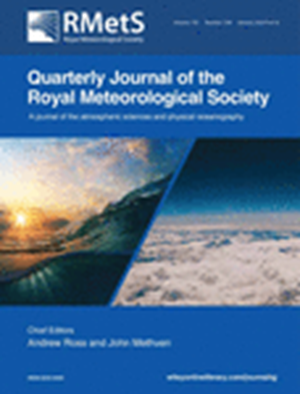制定面向用户的极地低纬度预报核查方法
IF 2.9
3区 地球科学
Q2 METEOROLOGY & ATMOSPHERIC SCIENCES
引用次数: 0
摘要
极地低谷呈现出天气对比非常鲜明的特征。在天气预报中,危险高风速区域的位置稍有偏差,就会对生活在极地地区的人们造成致命影响。因此,对空间验证方法的一种新应用进行了测试,以客观衡量危险天气区域的大小、形状和位置。为了将极地低纬度位置和运动方向误差的影响与极地低纬度中心误差的影响区分开来,以极地低纬度中心为中心,根据极地低纬度周围的背景气流方向旋转来自有限区域天气预报模式 "中尺度-北极研究与业务应用 "和哥白尼气候变化服务北极区域再分析的地表风场。然后,利用 2019 年 10 月的一个测试案例,探讨了基于特征的验证方法 SAL(结构、振幅、位置)和 MODE(基于对象的诊断评估方法)的可能性。研究表明,该方法可以提供有关预报性能的有价值信息。MODE 是一种灵活的方法,其指标侧重于单个对象的特征,可根据手头的问题进行调整。例如,增加了对风暴眼大小的测量。另一方面,SAL 为全域提供了有效的汇总指标,在评估风速的总体分布时尤其有用。要评估正确或错误识别出的恶劣天气区域的数量,而不是其形状细节,应急分数更为合适。如果将该方法应用于更大的数据集,则可根据预报时长、地理区域和极地低气压类型来评估性能。该方法也可应用于其他类型的低压系统,如外热带气旋。本文章由计算机程序翻译,如有差异,请以英文原文为准。
Developing a methodology for user‐oriented verification of polar low forecasts
Polar lows exhibit features with very sharp weather contrasts. In weather forecasting, a small misplacement of areas with hazardously high wind speeds can have fatal impacts for people living in polar regions. Therefore, a novel application of spatial verification methods for objective metrics of size, shape, and location of areas with hazardous weather is tested. To separate the effect of errors in polar low location and direction of motion from errors relative to the polar low centre, surface wind fields from the limited‐area weather forecasting model Applications of Research to Operations at Mesoscale‐Arctic and Copernicus Climate Change Service Arctic Regional Reanalysis are centred at the polar low centre and rotated according to the direction of background flow surrounding the polar low. Then the possibilities of the features‐based verification methods SAL (structure, amplitude, location) and MODE (Method for Object‐based Diagnostic Evaluation) are explored using a test case from October 2019. The study demonstrates that the methodology can provide valuable information about forecast performance. MODE is a flexible method with metrics that focus on characteristics of individual objects and can be adapted to questions at hand. For example, a measure of storm eye size was added. SAL, on the other hand, provides effective summary metrics for the full domain and proved particularly useful for evaluation of the overall distribution of wind speed. To evaluate the number of correctly or incorrectly identified areas with harsh weather rather than their details about their shape, contingency scores are more suitable. Applied to a larger dataset, this methodology can assess performance as a function of forecast length, as well as geographical area, and the type of polar low. The methodology can also be applied to other types of low‐pressure systems, such as extratropical cyclones.
求助全文
通过发布文献求助,成功后即可免费获取论文全文。
去求助
来源期刊
CiteScore
16.80
自引率
4.50%
发文量
163
审稿时长
3-8 weeks
期刊介绍:
The Quarterly Journal of the Royal Meteorological Society is a journal published by the Royal Meteorological Society. It aims to communicate and document new research in the atmospheric sciences and related fields. The journal is considered one of the leading publications in meteorology worldwide. It accepts articles, comprehensive review articles, and comments on published papers. It is published eight times a year, with additional special issues.
The Quarterly Journal has a wide readership of scientists in the atmospheric and related fields. It is indexed and abstracted in various databases, including Advanced Polymers Abstracts, Agricultural Engineering Abstracts, CAB Abstracts, CABDirect, COMPENDEX, CSA Civil Engineering Abstracts, Earthquake Engineering Abstracts, Engineered Materials Abstracts, Science Citation Index, SCOPUS, Web of Science, and more.

 求助内容:
求助内容: 应助结果提醒方式:
应助结果提醒方式:


